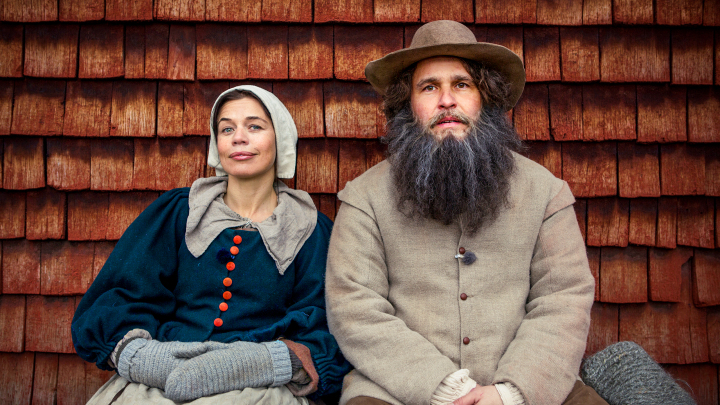Herring has a long history in the Swedish food culture. But it didn’t appear on the public’s Christmas table until the 19th century and is now a staple at most Swedish holidayfeasts. Food culture expert Richard Tellström, who has written scripts for SVT’s Historieätarna, is very concerned about the future of herring.
– In every way; in terms of sustainability, environment and food culture. It’s completely bizarre that we can’t stop the overfishing. If the fishing industry is allowed to continue for a few more years, the herring will be gone.
Herring was a foodsource in Sweden as early as the Stone Age. Since then, herring has been more or less constant throughout the centuries in Swedish food culture.
– It has always been there. It’s ancient, people have been eating herring as far back as there have been people, says Richard Tellström, associate professor of foodculture at SLU.
It has had several golden ages, including in 12th century Skåne and 18th century Bohuslän. The herring prosperity has financed the building of castles and churches and has nourished Swedes from summer to spring.
– Since there was a summer surplus of herring, people could save for the winter.
But it wasn’t until the 18th century that the popular fish really became “party food”. It was then that people in the higher standings in society began to eat pickled herring with South East Indian spices. This was called spiced herring – something we now very strongly associate with the Christmasdinner.
– It was not something that was eaten by the common people, because the ingredients are expensive.

Richard Tellström. Photo: Thomas-Szendrö
The pickled herring was part of the so called ‘brandy table’ of the bourgeoisie and nobility.
– It was an important meal. In fact, it marks the beginning of all the great festive dinners of the 18th century.
The brandy table
Existed already in the 16th century, but became common in the 18th century. Below is an excerpt from a festive event with a brandy table at Hotel Horn in Malmö.
“Like a church in a village, the hexagonal silver brandy canteen stood in the middle of the table (…) In the glass angles on either side of the canteen were placed the hams, a lard and a boiled one (…) Next to the brandy glasses were the salty things: Seven kinds of herring, anchovies in a magnum jar, anchovies in a quarter box, cold roast pork and birds’ nests. Then came the eel, smoked. grilled or cooked in jelly. And then platters were added to platters, plate to plate, like pieces in an inlay, where light green garnish leaves, scarlet cucumbers and white cucumbers, beets, herring salad, red cheeses and cheeses in tin foil formed the green element in the more colorful mass of cold cuts, pig’s feet, veal and pig’s head jams, sausages, meatballs and minced beef with onions. The head waiter leaned over the table and tested the temperature of the brandy canteen with the back of his hand. When this was found to be satisfactory, he began to pull the lighted cords under the chandelier. The head waiter compared his pocket watch with the wall clock. Hotel Horn was ready to receive the drinkers. And they came in droves.”
Source: Nordiska museet
The important basic flavors in herring
The brandy table consisted of butter, bread, cheese, pickled herring, salted salmon or meat – and, of course, the brandy. It was an appetizer of sorts, and this type of meal starter would later make a big impact on Swedish festive food culture. At the end of the 19th century, the brandytable was transformed into the smörgåsbord. The christmas smörgåsbord is considered festive Christmas food in most social classes and it is also then that the pickled herring becomes a festive dish in itself.
– It becomes a festive entré at Easter, Midsummer, and indeed all celebrations in the country.
So, according to Richard, pickled herring is a “very old flavor tradition” that is now synonymous with holidays. One reason as to why it has been so popular and long-lasting on the Christmas table might be its contribution to the flavor palette.
– It contains the important basic flavors, salty, sweet, sour and umami. The only thing missing is perhaps the bitterness – that you can get by drinking a schnapps with wormwood.
Tomato herring and apple-mint
The festive herring has taken many forms since the first spicy herrings. We see herring flavored with sandalwood around the 1840s, in 1880 onion herring is introduced and at the beginning of the 20th century the glass master herring is born. Then herring creativity really takes off with, among other things, tomato herring and mustard herring in the 1920s.
– The next big change was in the late 1980s when dairies launched creme fraiche herring.
Today, herrings come in all sorts of flavors: chili aioli, bacon, mandarin pepper, apple mint. A jury at the Munsö/Ekerö Sea Rescue Station in Klädesholmen’s annual herring competition chose the flavor combination of green tea and citrus as this year’s herring. Other festive dishes with herring as an ingredient have also taken shape over the years.
Vegan herring?
For those who are vegetarian or vegan there are also fish-free “herrings”, which according to Richard actually shows even more how important herring is as a food cultural expression.
– The fact that people take the trouble to make pickled herring from eggplant or tofu shows that it has a very central position.
– “Matjesilltårtan”, created by journalist Berit Paulson in the late 1980s, and gubbröran from the early 1900s, for example. Then there is “nubbe salad”, which is gubbröra, but with creme fraiche.
Herring has an ability to innovate itself.
– Postmodern food culture is playful, taking something classic and giving it a twist.
However, the spicy herring’s foothold remains strong.
– It is not uncommon for a home to have four or five different pickles on the Christmas table. But there should always be spicy herring.

Where is the everyday herring?
The herring has been a staple of the Swedish diet since ancient times and has been used far beyond celebrations and festivities. Everyday herring was usually dried or salted – something to make soup or stew out of.
Dried herring is often referred to as krampsill, a fish variety that has almost completely disappeared.
– It was historically common, as people saved on salt, which was expensive.
The “krampsill” becomes U-shaped when it dries, hence the name – it cramps up. But it is a herring that not many people, including Richard, have tasted.
– In the recording of the tv-program “History Eaters”, we really tried to include krampsill. But we didn’t manage to get someone to dry it for us. So there was no krampsill, but we talked about it!

The progam “Historieätarna” with hosts Lotta Lundgren and Erik Haag. Photo: Andre Lindholm/Thelma&Louise
Other types of everyday herring are also absent today.
– There is almost no everyday herring left, due to depletion. The fresh herring and herring have fallen out of popular consumption.
How worried are you about the alarming reports about herring?
– In every way. It’s completely bizarre that you can’t stop the overfishing that leads to such imbalances in this inland sea that we have and that it is allowed to continue. It is extremely strange. It can’t be explained in understandable words – it’s bizarre, says Richard.
A complete disaster
Richard explains what happens to the cultural heritage if the herring is lost.
– If there is no herring left, people will express their cultural identity in other ways. There are other types of fish you can have on the brandy table. Cultural heritage is only carried out as long as it is important and as long as they are prioritized. It happens very quickly.
Sad but true, he concludes.
– Of course it is sad, but much of the herring we have in the herring cans today comes from the North Sea and the Atlantic. All fish can also be pickled as herring. If you like the pickling flavor but don’t like herring, you can use gravlax to put in the herring stock – it’s very tasty.
However, Richard points out that while food culture can change, ecology is another matter.
– From an environmental and sustainability point of view, losing herring is a complete disaster.

